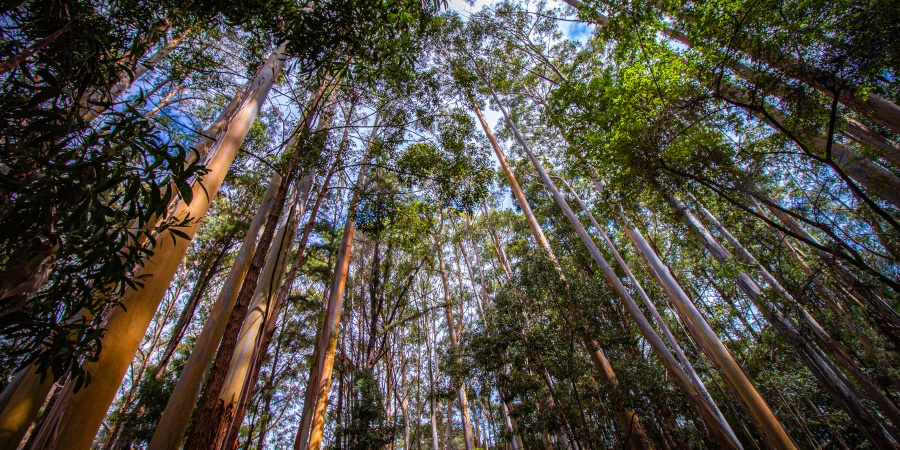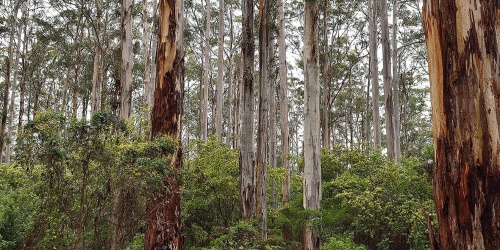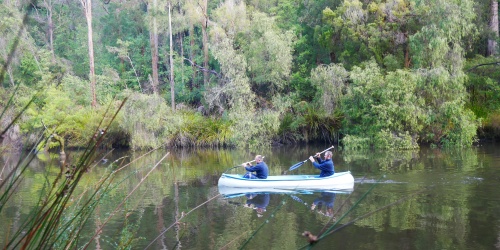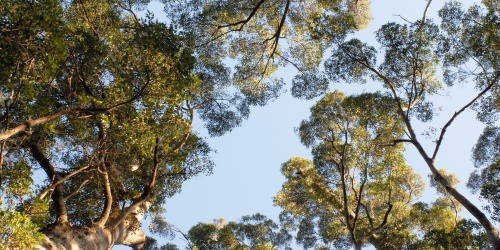
Karri Forest Warren National Park, Pemberton. Photo DBCA
This means providing economic, social and cultural benefits from our State forest and timber reserves while, at the same time, conserving biodiversity, maintaining soil and water values, and sustaining the health and resilience of the forest for current and future generations.
Who manages our forests?
The forest management plan provides the policy framework for managing south-west native forests until 2033.
Conservation and Parks Commission
The Conservation and Parks Commission is an independent authority that oversees the administration of Western Australia's national and marine parks, conservation parks, nature reserves, State forests and timber reserves by the department.
Department of Biodiversity, Conservation and Attractions
DBCA has the lead responsibility for protecting and conserving the State’s environment on behalf of the people of Western Australia. This responsibility includes monitoring activities which may disturb the environment, including timber harvesting. DBCA also provides planning and oversight to the ecological thinning of regrowth forests to promote health and resistance to conserve biodiversity.
The Forest Products Commission (FPC) is responsible for ecological thinning operations in native forests and harvesting and regenerating plantations in State forests and timber reserves. The FPC also coordinates the sale of forest products and some associated industry matters.
Key goals of forest management
- the conservation of biodiversity
- the recognition and protection of Aboriginal and other Australian cultural heritage
- sustaining the health, vitality and resilience of ecosystems in a changing climate
- the protection of soil and water resources
- sustaining the contribution to global carbon cycles
- managing the wide range of social, cultural and economic benefits valued by the community in line with the principles of ecologically sustainable forest management.
Western Australia's forest management system
Western Australia’s forest management system is designed to achieve ecologically sustainable forest management (ESFM) across both public and private land tenures within the State’s south-west.
The forest management system has a hierarchy of integrated components, commencing with an overarching legislative framework, supported by national and state policies, and underpinned by the planning and operations management systems which guide forest activities on the ground.

The forest management system has the following features:
Legislation, policy and key documents
A suite of primary legislation forms the core of the system, and major secondary legislation influences how the forest management system delivers ESFM. These influences include the need to protect biodiversity and matters of national environmental significance (such as Ramsar wetlands, National Heritage places, threatened species and communities, or migratory species); the need to provide for multiple or specific benefits from the forests (such as provision for water, mining access, tourism or other); and recognition of Aboriginal connection and traditional ownership of lands and country.
Planning
Strategic through to operational planning processes are conducted to integrate the various objectives for forest management and guide activities on the ground.
Western Australia’s Regional Forest Agreement (WA RFA) provides a strategic framework for delivering ESFM, through the establishment of a Comprehensive, Adequate and Representative (CAR) reserve system to ensure the long-term conservation and protection of forest biodiversity, old-growth forest and wilderness values; the management of multiple-use forests outside reserves for the range of conservation and productive uses. industries.
A forest management plan (prepared in accordance with the Conservation and Land Management Act 1984) provides the policy and planning framework for managing public forests in the south west, and gives effect to the WA RFA objectives and commitments. The current forest management plan is the Forest Management Plan 2024-2033 (FMP) which implements State government policy for the cessation of native forest timber harvesting and expanding the reserve system. Specific area management plans are also prepared for conservation reserves including national parks and nature reserves.
Management controls
Subsidiary guidelines, manuals, codes of practice and operational prescriptions under the FMP guide and control the on-ground disturbance and conservation management activities in public forest (such as prescribed burning, ecological thinning, infrastructure development, and invasive species control).
Private forests
Forests on private land contribute to environmental, social and economic outcomes. Sustainable management is approached through regulation to control vegetation clearing, protection of indigenous flora and fauna, and the establishment of voluntary conservation mechanisms.
Adaptive and responsive
The forest management system incorporates adaptive management and continuous improvement processes to respond to evolving environmental, social and economic factors. Research findings, feedback from monitoring, compliance, certification and enforcement systems, and stakeholder engagement are used to inform periodic review processes.
An overview of Western Australia’s forest management system is being reviewed to support the WA RFA and th FMP and will be available in the coming months. This document will outline the framework (both Commonwealth and State) comprising the suite of legislation, policies, codes of practice, procedures, plans and management processes for forest management. The document will also address the management of forests on both private and public land (which includes forest reserves and multiple-use State forests), including Commonwealth Matters of National Environmental Significance.
What are Regional Forest Agreements?
Regional Forest Agreements (RFAs) are 20-year plans for the conservation and sustainable management of Australia's native forests. Learn more about RFAs on our Regional Forest Agreement page.
Silviculture
This content is under review. New information will soon be available.
Legislation, policy and key documents
Management of our forests is regulated by the:
The Commonwealth Environment Protection and Biodiversity Conservation Act 1999 also contains provisions to protect nationally-listed threatened species and ecological communities.
The Regional Forest Agreement for the South-West Forest Region of Western Australia is a 20-year agreement between the State and Commonwealth governments on the use and management of the forests of Western Australia's south-west
Other relevant legislation, policies and key documents are outlined in the Forest Management Plan 2024-2033.
Protecting our biological diversity
Biological diversity or biodiversity is the variety of all life forms on earth - the different plants, animals and micro-organisms, their genes, and the ecosystems of which they are a part, from the smallest one-cell microbe to the ancient giant tuart forest.
Australia is home to between 600,000 and 700,000 species. About 84 per cent of our plants and mammals, and 45 per cent of our birds are only found in Australia.
Western Australia is home to many of these plants and animals. The state's south-west, in particular, has some of the richest diversity of plants and animals on earth.
Biodiversity in forests is protected by measures such as keeping physical corridors or links between habitats, and maintaining ecological processes such as decomposition and nutrient cycling. We also need to restore the environment by protecting threatened species, and tackling threats such as feral animals, weeds and Phytophthora dieback.



